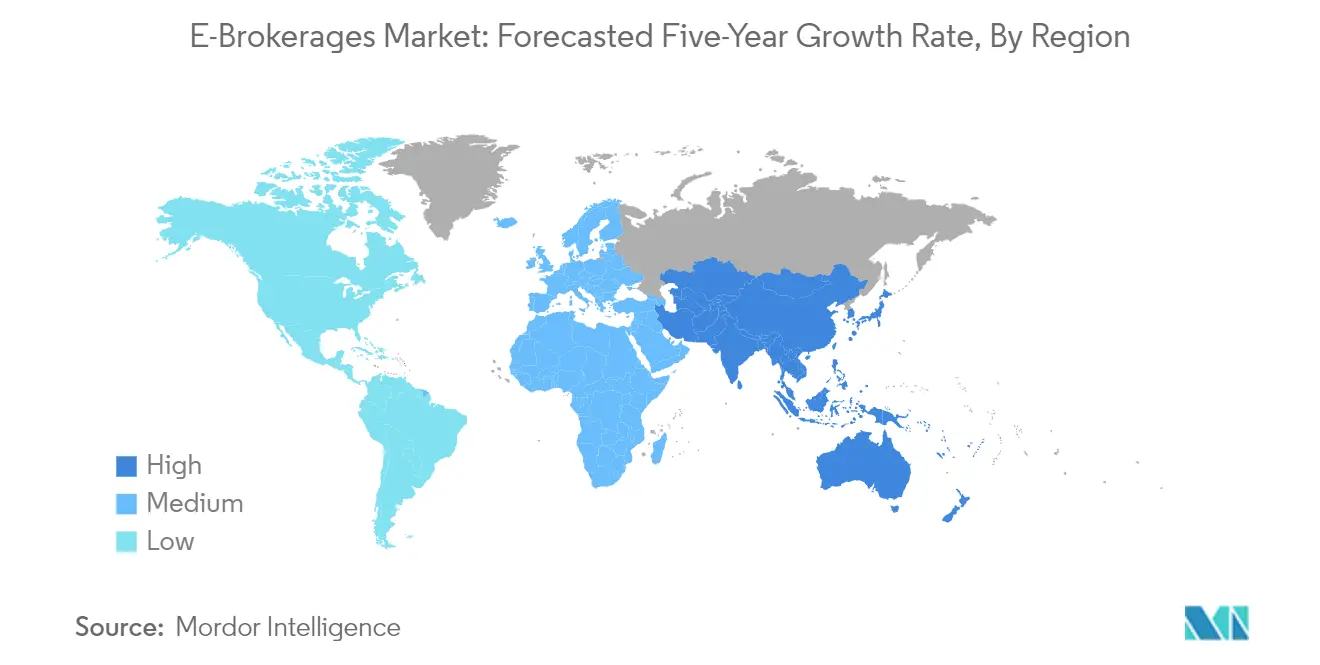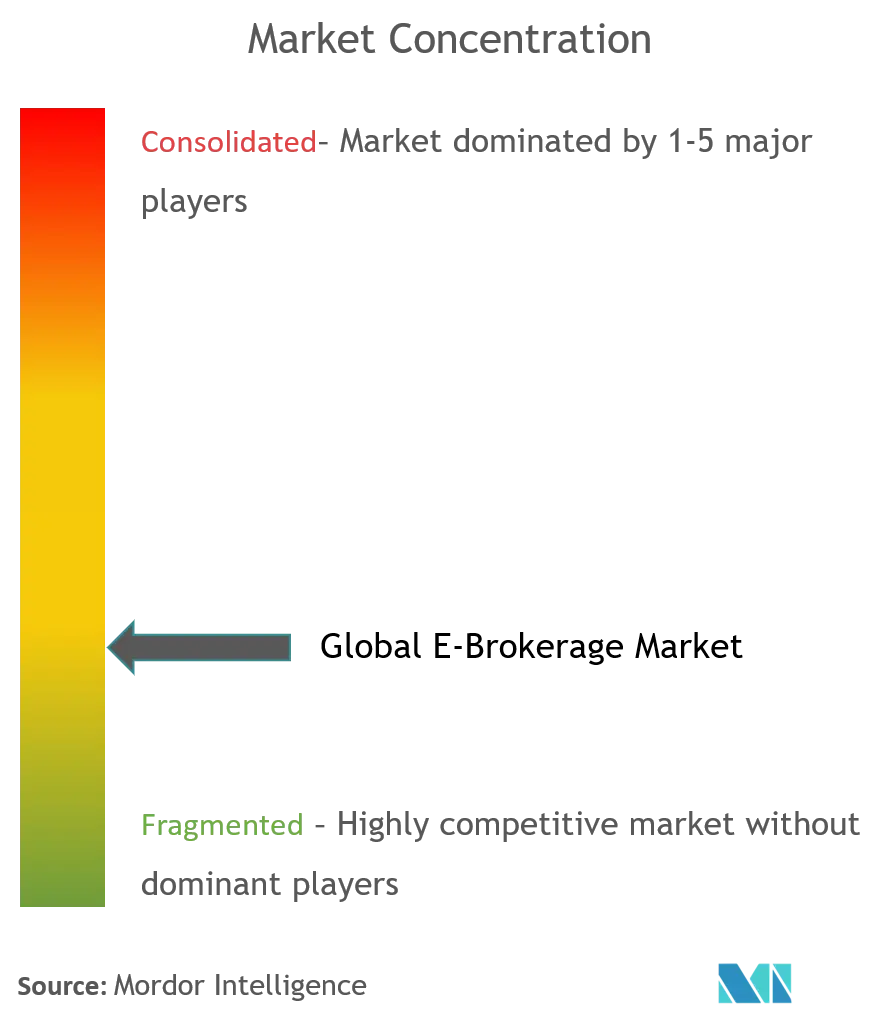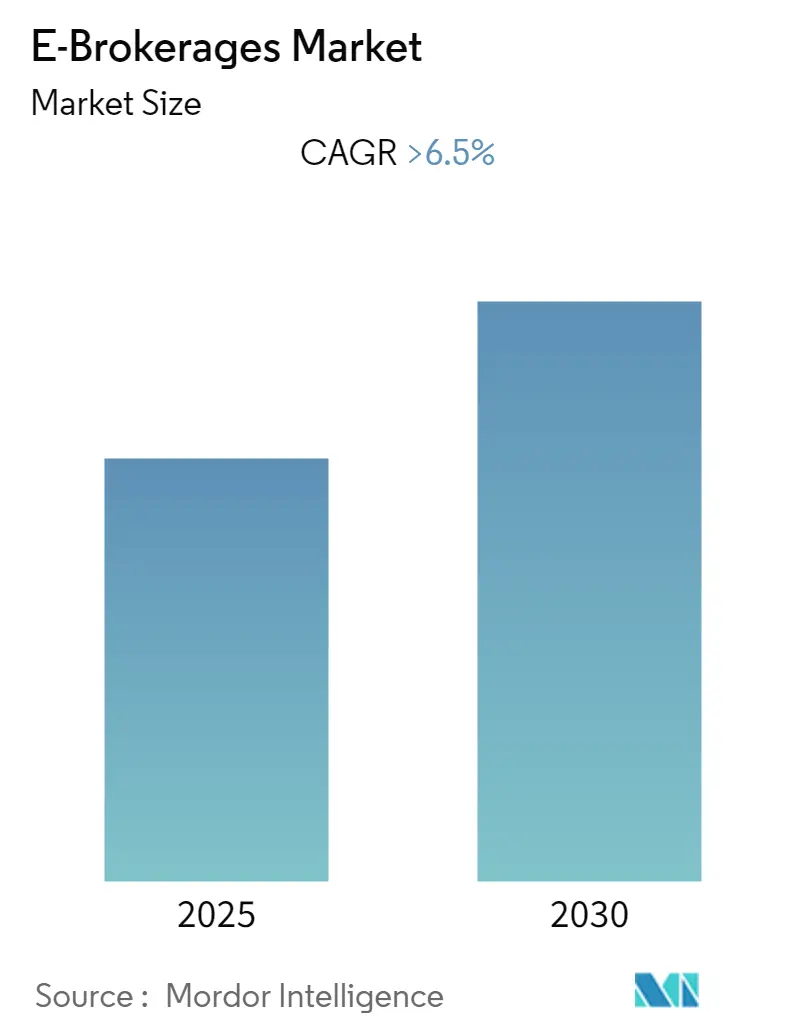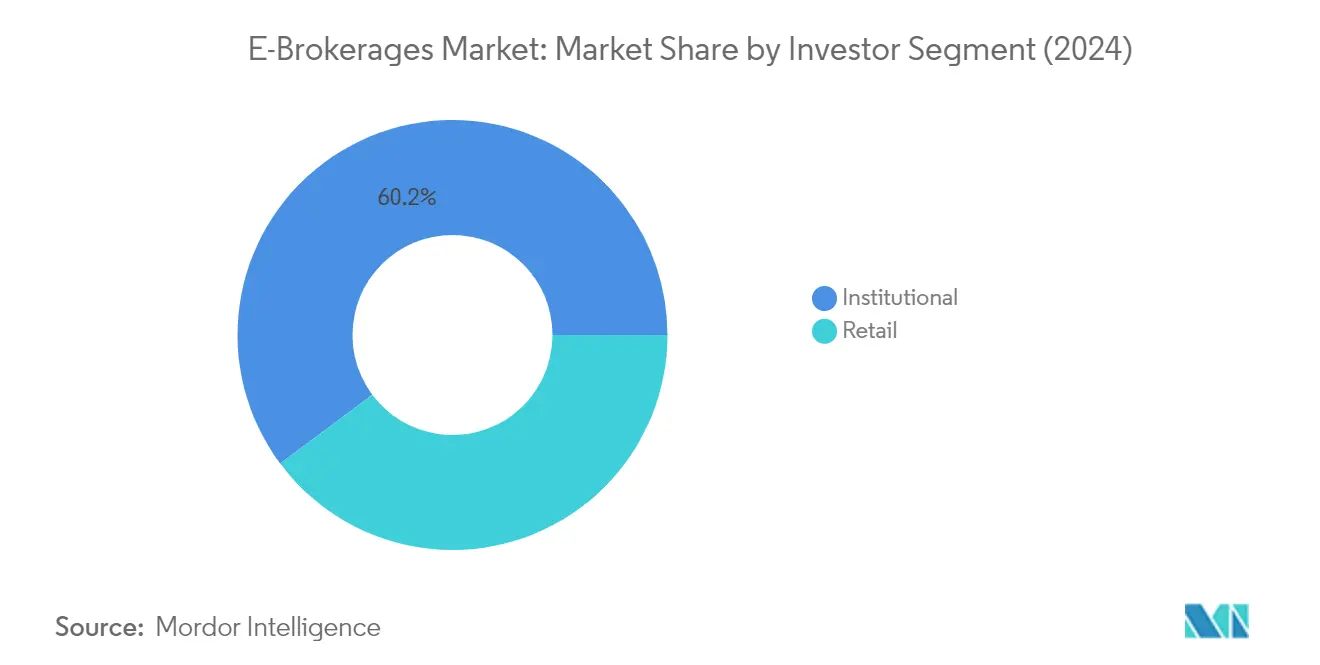Online Brokerage Market Analysis
The E-Brokerages Market is expected to register a CAGR of greater than 6.5% during the forecast period.
The brokerage industry is experiencing a significant transformation driven by technological innovation and changing investor preferences. Leading platforms are increasingly integrating advanced technologies like artificial intelligence, blockchain, and machine learning to enhance trading capabilities and user experience. This digital evolution has led to the emergence of sophisticated trading platforms offering features like robo-advisors, social trading, and automated portfolio management. The industry's technological advancement is exemplified by major players like Fidelity Investments, which now serves over 40 million individual investors and 25,000 businesses with their innovative investment and technology solutions.
The democratization of investing continues to reshape the industry landscape, with commission-free trading becoming the new standard among major online brokerages. This shift has significantly lowered barriers to entry for retail investors, leading to unprecedented market participation levels. The impact of this transformation is evident in the market structure, with retail investors now owning approximately 14% of the stock market in the United Kingdom, highlighting the growing influence of individual investors in global financial markets. E-brokers are responding by expanding their educational resources and developing more intuitive trading interfaces to support this growing investor base.
Environmental, Social, and Governance (ESG) investing has emerged as a crucial focus area for e-brokers, with platforms expanding their offerings to meet growing demand for sustainable investment options. According to industry data, 66% of institutional investors have implemented ESG integration strategies in their investment decisions, demonstrating the mainstream adoption of sustainable investing practices. E-brokers are responding by developing specialized ESG screening tools, sustainable fund offerings, and detailed ESG analytics to help investors align their portfolios with their values while maintaining strong financial performance.
The industry is witnessing significant consolidation and strategic partnerships as firms seek to enhance their competitive positions. Major e-brokers are expanding their service offerings beyond traditional trading to include comprehensive financial planning, banking services, and wealth management solutions. This evolution is reflected in the robust growth of assets under management, with industry leader Charles Schwab managing over USD 7.05 trillion in client assets and serving 33.8 million active brokerage accounts. E-brokers are also investing heavily in cybersecurity infrastructure and regulatory compliance systems to maintain trust and security in an increasingly complex digital financial ecosystem.
Online Brokerage Market Trends
Growing Retail Investments Globally
The global brokerage growth is experiencing substantial growth driven by increasing retail investor participation across markets worldwide. The democratization of investment through technology and changing attitudes toward investing has led to unprecedented retail investor engagement, with over 500 million active e-brokerage accounts recorded globally as of 2021. The rising availability of online broker services and mobile applications has been fundamental in driving this surge, making it easier and more affordable than ever for individual investors to purchase and sell securities such as stocks, bonds, and cryptocurrencies.
The growing interest in investing among younger generations, particularly Millennials and Generation Z, has been a crucial factor in expanding retail participation. These demographics have shown greater investment inclination compared to previous generations, partly due to their familiarity with digital technologies and ready access to information. Social media and online forums have further fueled this enthusiasm by creating communities where investors can share information and ideas. Additionally, retail investors' involvement in traditional equities and debt markets, as well as new alternative assets, has increased significantly, with retail investors accounting for approximately 52% of the world's assets under management in 2021. This trend is expected to continue as more individuals seek to take control of their financial futures through direct market participation.
Competitive Pricing of Brokerage Services and Other Advantages
The e-brokerage market has witnessed a revolutionary shift in pricing structures, with many financial service providers implementing zero-commission trading to attract and retain customers. This trend, initially popularized by mobile app-based brokerages like Robinhood Markets Inc., has now been adopted by major financial institutions, including Fidelity Investments and JPMorgan Chase & Co. Brokerages have diversified their revenue streams beyond traditional commission fees, focusing on services such as margin lending, securities lending to short sellers, and investing client cash balances through banking subsidiaries, demonstrating the industry's adaptability and commitment to competitive pricing.
The technological advancement in the e-brokerage sector has further enhanced competitive advantages, with platforms increasingly adopting blockchain and artificial intelligence technologies to improve accuracy and efficiency. For instance, trading platforms like Empirica have introduced sophisticated algorithms such as the Volume-Weighted Average Price (VWAP), which helps reduce market price impact when executing larger orders. The combination of automation, algorithms, and high-fidelity trading has been driven by increasing trends in electronic trading, aiming to simplify trade execution and enable advanced trading strategies. Additionally, the demand for customized trading platforms has grown as end-users seek specialized solutions, particularly in government securities markets where Electronic Trading Platforms (ETPs) contribute significantly to market growth.
Segment Analysis: By Investor
Institutional Segment in E-Brokerages Market
The institutional segment dominates the global e-brokerages market, commanding approximately 60% of the market share in 2024. This segment consists of major players like pension funds, endowments, foundations, insurance firms, and sovereign wealth funds that manage substantial amounts of money on behalf of their clients or beneficiaries. The segment's dominance is particularly pronounced in North America, which accounts for the highest percentage of assets under management (AUM), followed by Europe and Asia-Pacific. These institutional investors are increasingly adopting innovative technologies and platforms to streamline their investment processes, with a growing emphasis on environmental, social, and governance (ESG) investing. Major institutional players like BlackRock, Vanguard, and Fidelity are continuously developing sophisticated trading platforms that allow institutional investors to execute trades efficiently while providing advanced analytics capabilities and real-time market information.
Retail Segment in E-Brokerages Market
The retail segment in the e-brokerages market is experiencing rapid growth, with an expected growth rate of approximately 9% from 2024 to 2029. This accelerated growth is driven by increasing digitalization and the democratization of investment through technology, making financial markets more accessible to individual investors. The segment's growth is further fueled by the rising adoption of mobile trading applications, which provide seamless trading experiences and real-time market information. Retail investors are showing increased interest in diverse investment options, including stocks, cryptocurrencies, and sustainable investments, while also embracing new features like fractional share trading and robo-advisory services. The segment is particularly attractive to millennial and Gen-Z investors, who are more comfortable with digital technologies and are seeking user-friendly platforms that offer educational resources and innovative trading tools.
Segment Analysis: By Services Provider
Full-time Brokers Segment in E-Brokerages Market
Full-time brokers dominate the global e-brokerages market, commanding approximately 56% of the market share in 2024. These brokers provide comprehensive financial services, including access to various financial products like stocks, bonds, options, and futures, along with sophisticated online trading platforms, extensive research tools, and professional investment guidance. The segment's strong market position is supported by their ability to offer personalized services, advanced trading capabilities, and comprehensive educational resources to help investors make informed decisions. Full-time brokers have also been investing heavily in technological advancements, incorporating features like artificial intelligence and machine learning to enhance their trading platforms and provide more personalized investment recommendations to their clients. Major players in this segment continue to expand their service offerings, focusing on mobile trading capabilities and integrating new technologies to maintain their competitive edge in the stock brokerage industry.
Discounted Brokers Segment in E-Brokerages Market
The discounted brokers segment is experiencing the fastest growth in the e-brokerages market, with a projected growth rate of approximately 8% from 2024 to 2029. This rapid growth is driven by increasing demand from cost-conscious investors seeking more affordable trading options. Discounted brokers are revolutionizing the brokerage market by leveraging technology to offer streamlined, self-service trading platforms with minimal fees and commissions. The segment's growth is further accelerated by the rising adoption of mobile trading apps, which make investing more accessible to a broader range of investors, particularly millennials and Gen Z. These brokers are continuously innovating their platforms by introducing features like fractional shares trading, commission-free trading options, and user-friendly interfaces that appeal to both novice and experienced investors looking for cost-effective trading solutions.
Segment Analysis: By Ownership
Publicly Held Segment in E-Brokerages Market
The publicly held segment dominates the global e-brokerages market, commanding approximately 69% of the total market share in 2024. This segment consists of well-established online brokerage firms that are traded on their respective national stock exchanges, including major players like Interactive Brokers, E-Trade, Fidelity Investments, Charles Schwab, and TD Ameritrade in the United States. The segment's dominance can be attributed to these companies' strong market presence, extensive service offerings, and robust technological infrastructure. Publicly held e-brokers typically benefit from greater access to capital through public markets, enabling them to invest in advanced trading platforms, expand their service offerings, and pursue strategic acquisitions. These companies also tend to have more diverse revenue streams, offering services ranging from traditional brokerage activities to wealth management, banking services, and institutional trading platforms.
Privately Held Segment in E-Brokerages Market
The privately held segment in the e-brokerages market is demonstrating remarkable growth potential, with projections indicating an expansion rate of approximately 9% during the forecast period 2024-2029. This segment comprises relatively newer market entrants and innovative fintech companies that are disrupting traditional brokerage models. Private e-brokers are showing particular strength in developing specialized trading platforms, implementing cutting-edge technologies, and offering unique value propositions to specific market niches. These companies are often more agile in their operations and can quickly adapt to changing market conditions and customer preferences. The segment's growth is being driven by factors such as increased adoption of digital trading platforms, rising interest in commission-free trading models, and the growing preference for mobile-first trading solutions among younger investors.
E-Brokerages Market Geography Segment Analysis
E-Brokerages Market in North America
North America continues to dominate the broker market share in the global e-brokerages market, commanding approximately 55% of the total market share in 2024. The region's leadership position is primarily driven by advanced technological infrastructure and high digital literacy rates among investors. The United States and Canada have established themselves as pioneers in innovative trading platforms and investment solutions, with Toronto being one of North America's most significant financial centers. The market is characterized by sophisticated regulatory frameworks, particularly through organizations like the Securities and Exchange Commission (SEC) and the Canadian Securities Administrators (CSA), which provide robust investor protection. The region's e-brokerage landscape is marked by intense competition among major players, leading to continuous innovation in service offerings and competitive pricing structures. The presence of tech-savvy millennials and their increasing participation in stock markets has further accelerated the adoption of mobile trading platforms and digital investment solutions. Additionally, the region benefits from a strong ecosystem of financial technology companies that consistently introduce cutting-edge trading tools and analytics capabilities.

E-Brokerages Market in Europe
The European e-brokerages market has demonstrated remarkable growth, expanding at approximately 16% annually from 2019 to 2024. The market's evolution is shaped by diverse investment styles across different countries, with Germany emerging as the largest market in terms of trading volumes and Sweden leading in the number of executed trades. The European market operates under the comprehensive Markets in Financial Instruments Directive (MiFID II) framework, ensuring transparent and standardized trading practices across the region. The market structure is characterized by a mix of traditional banking institutions and innovative fintech companies, creating a dynamic competitive environment. The region has witnessed significant adoption of mobile trading applications, with platforms like Trade Republic gaining prominence in Germany and eToro establishing a strong presence in the United Kingdom. The market is further strengthened by the European Union's continuous efforts to create a unified capital market, fostering cross-border investment opportunities and standardized regulatory practices. Additionally, the increasing focus on sustainable and ESG-focused investing has created new opportunities for global brokerage firms to differentiate their offerings.
E-Brokerages Market in Asia-Pacific
The Asia-Pacific e-brokerages market is positioned for robust expansion, with projections indicating a growth rate of approximately 9% during the 2024-2029 period. The region's market dynamics are significantly influenced by the rapid digitalization of financial services and the growing middle-class population across major economies like China, India, and Japan. The market is characterized by increasing adoption of mobile trading platforms, particularly among younger investors who show a strong preference for digital investment solutions. Local regulatory bodies are actively working to create supportive frameworks for online trading while ensuring adequate investor protection measures. The competitive landscape is marked by a mix of established financial institutions and innovative fintech startups, driving technological advancement and service innovation. The region's e-brokerage sector is also benefiting from significant investments in financial technology infrastructure and the growing integration of artificial intelligence and machine learning in trading platforms. Furthermore, the market is witnessing a transformation in investment behavior, with a rising interest in international market access and diversified investment products. This transformation highlights the growing importance of the online brokerage market in the region.
E-Brokerages Market in South America
The South American e-brokerages market is experiencing a transformative phase driven by changing investor preferences and increasing digital adoption. The region's market is characterized by a growing acceptance of online trading platforms, particularly in Brazil, which serves as the primary growth engine for the region. The market structure is evolving with the emergence of digital investment platforms that are making financial markets more accessible to retail investors. Traditional banks in the region are actively expanding their digital capabilities to compete with emerging fintech players, leading to improved service offerings and competitive pricing. The market is benefiting from regulatory reforms aimed at increasing market transparency and protecting investor interests. Educational initiatives by e-brokerages are playing a crucial role in expanding the investor base by increasing financial literacy among the population. The competitive landscape is marked by both local players with strong regional understanding and international platforms seeking to establish their presence in this growing market. This evolving landscape is a key focus of broker market analysis.
E-Brokerages Market in Middle East & Africa
The Middle East and African e-brokerages market is demonstrating significant potential, driven by the region's young, tech-savvy population and increasing digital penetration. The market is characterized by rapid technological adoption, particularly in the Gulf Cooperation Council (GCC) countries, where financial technology integration is reshaping traditional trading practices. The UAE has emerged as a key hub for e-brokerages, supported by progressive regulatory frameworks and initiatives to promote financial technology innovation. The market is witnessing increased participation from international brokers who are establishing a regional presence through local licenses and partnerships. The competitive landscape is evolving with the entry of new players offering innovative trading solutions tailored to local market needs. The region's e-brokerage sector is benefiting from significant investments in digital infrastructure and growing efforts to increase financial inclusion. Additionally, the market is characterized by an increasing focus on Islamic finance-compliant trading solutions, catering to the specific needs of the regional investor base. This focus further enhances the brokerage market share in these regions.
Online Brokerage Industry Overview
Top Companies in E-Brokerages Market
The global e-brokerages market is dominated by established players like Charles Schwab, Fidelity Investments, Interactive Brokers, TD Ameritrade, and E-Trade, who have demonstrated a strong market presence through continuous innovation and strategic growth. These companies have been focusing on expanding their digital capabilities through cloud-based systems and advanced trading platforms while simultaneously reducing trading commissions to attract a broader customer base. The industry has witnessed significant product innovation trends, including the introduction of fractional share trading, cryptocurrency trading capabilities, and robo-advisory services. Operational agility has been demonstrated through the rapid adoption of mobile-first approaches and the integration of artificial intelligence for personalized investment recommendations. Strategic moves have primarily centered around mergers and acquisitions to consolidate brokerage market share, while geographical expansion has been pursued through partnerships with local financial institutions and technology providers in emerging markets.
Consolidation and Competition Shape Market Dynamics
The e-brokerages market exhibits a moderately fragmented structure, characterized by the presence of both global financial conglomerates and specialized online brokerage firms. Traditional financial institutions have maintained their dominance through extensive resource capabilities and established brand trust, while specialized e-brokers have carved out their niche through technological innovation and competitive pricing strategies. The market has witnessed significant consolidation through strategic acquisitions, particularly among larger players seeking to enhance their technological capabilities and expand their customer base. Regional players, especially in Asia-Pacific markets like India and China, have emerged as strong contenders by leveraging their local market knowledge and customized service offerings.
The competitive landscape has been transformed by the entry of fintech startups and the increasing participation of traditional banks in the online brokerage space. Market consolidation has been driven by the need to achieve economies of scale and enhance technological capabilities, with larger players acquiring smaller, innovative platforms to strengthen their market position. The industry has seen a shift towards partnerships between financial services providers and fintech companies, creating new opportunities for market expansion and service enhancement. This collaborative approach has become increasingly important as companies seek to combine traditional financial expertise with innovative technology solutions.
Innovation and Adaptation Drive Future Success
Success in the e-brokerages market increasingly depends on the ability to balance technological innovation with customer-centric services. Incumbent players must focus on enhancing their digital capabilities while maintaining competitive pricing structures and expanding their product offerings to include emerging investment options like cryptocurrencies and sustainable investing products. The integration of advanced technologies such as artificial intelligence and machine learning for personalized investment recommendations has become crucial for maintaining market share. Companies must also address the growing demand for educational resources and user-friendly interfaces to attract and retain the next generation of investors.
Market contenders can gain ground by focusing on niche market segments and developing specialized services that address specific customer needs. The ability to offer innovative features while maintaining robust security measures and regulatory compliance will be crucial for success. End-user concentration remains a significant factor, with millennials and tech-savvy investors becoming increasingly important target segments. The threat of substitution from alternative investment platforms and potential regulatory changes regarding trading practices and data security presents ongoing challenges that market players must navigate. Companies must maintain flexibility in their business models to adapt to evolving regulatory requirements while continuing to innovate and expand their service offerings. The brokerage industry must also keep an eye on the largest brokerage firms globally to benchmark their services and strategies effectively.
Online Brokerage Market Leaders
-
Fidelity Investments
-
Charles Schwab Corporation
-
E-Trade
-
Interactive Brokers
-
Etoro
- *Disclaimer: Major Players sorted in no particular order

Online Brokerage Market News
- May 2022: Interactive Brokers partnered with TradingView. The new partnership was like a win-win for all parties, particularly for Interactive broker clients as they were now trading directly from their TradingView workspaces and charts.
- May 2022: Fidelity International partnered with Canadian FinTech company, Conquest, as the exclusive distributor of its financial planning software, 'Conquest Planning' to the UK independent advice market.
- August 2022: eToro, a multi-asset social investment network, has struck a formal agreement to buy Gatsby, a fintech firm that also hoped to compete with Robinhood, for USD 50 million in cash and common shares.
Online Brokerage Industry Segmentation
An online broker, on the other hand, is a broker that interacts with clients over the Internet, rather than in person. An online brokerage is a brokerage that clients go to, rather than a physical brokerage office. Because the overhead costs associated with a physical brokerage office are higher than those associated with an online brokerage, online brokers charge lower fees. The E-brokerage Market is segmented by Client (Retailers, Institutional), by Services Provided (Full Time Brokers, Discounted Brokers), by Ownership (Privately Held, Publicly Held), and by Geography (North America, Europe, Asia-Pacific, South America, Middle East and Africa). The report offers market size and forecast values for the E-Brokerages Market in USD million for the above segments.
| Client | Retailers |
| Institutional | |
| Services Provided | Full Time Brokers |
| Discounted Brokers | |
| Ownership | Privately Held |
| Publicly Held | |
| Geography | North America |
| Europe | |
| Asia Pacific | |
| South America | |
| Middle East and Africa |
| Retailers |
| Institutional |
| Full Time Brokers |
| Discounted Brokers |
| Privately Held |
| Publicly Held |
| North America |
| Europe |
| Asia Pacific |
| South America |
| Middle East and Africa |
Online Brokerage Market Research FAQs
What is the current E-Brokerages Market size?
The E-Brokerages Market is projected to register a CAGR of greater than 6.5% during the forecast period (2025-2030)
Who are the key players in E-Brokerages Market?
Fidelity Investments, Charles Schwab Corporation, E-Trade, Interactive Brokers and Etoro are the major companies operating in the E-Brokerages Market.
Which is the fastest growing region in E-Brokerages Market?
Asia Pacific is estimated to grow at the highest CAGR over the forecast period (2025-2030).
Which region has the biggest share in E-Brokerages Market?
In 2025, the South America accounts for the largest market share in E-Brokerages Market.
What years does this E-Brokerages Market cover?
The report covers the E-Brokerages Market historical market size for years: 2020, 2021, 2022, 2023 and 2024. The report also forecasts the E-Brokerages Market size for years: 2025, 2026, 2027, 2028, 2029 and 2030.





